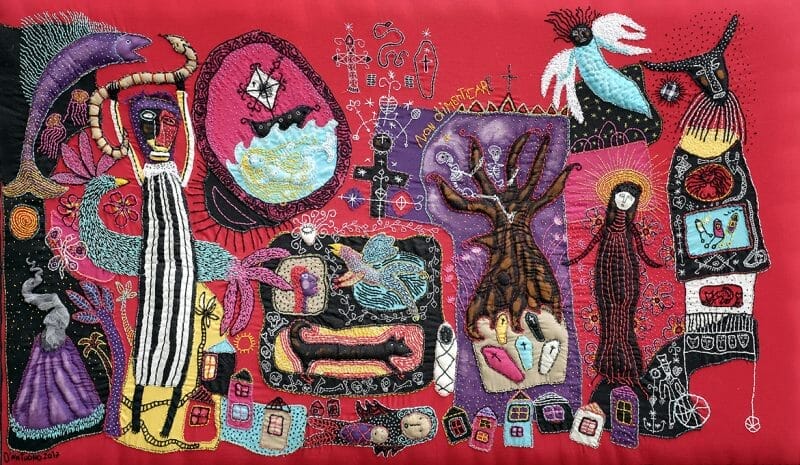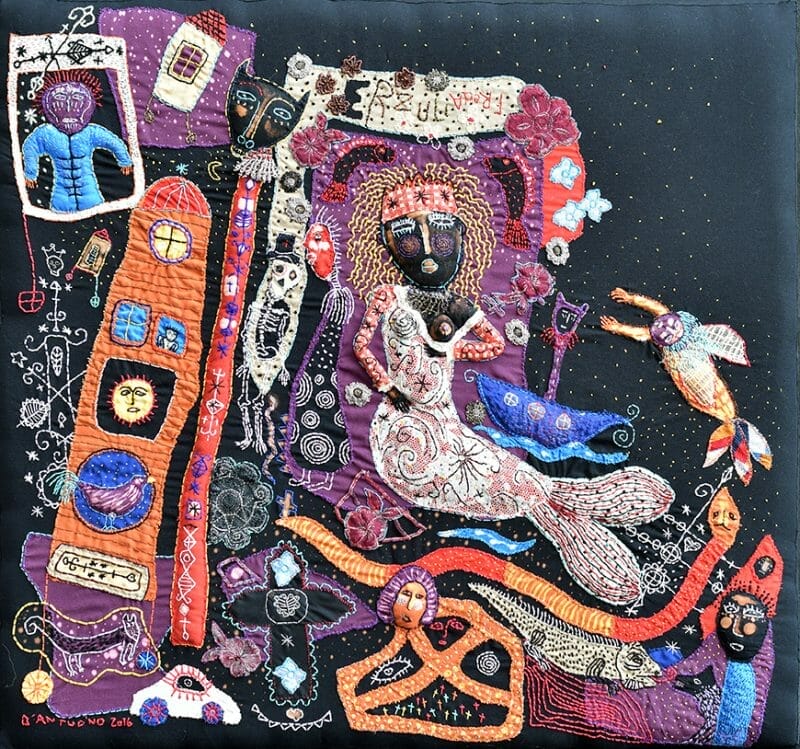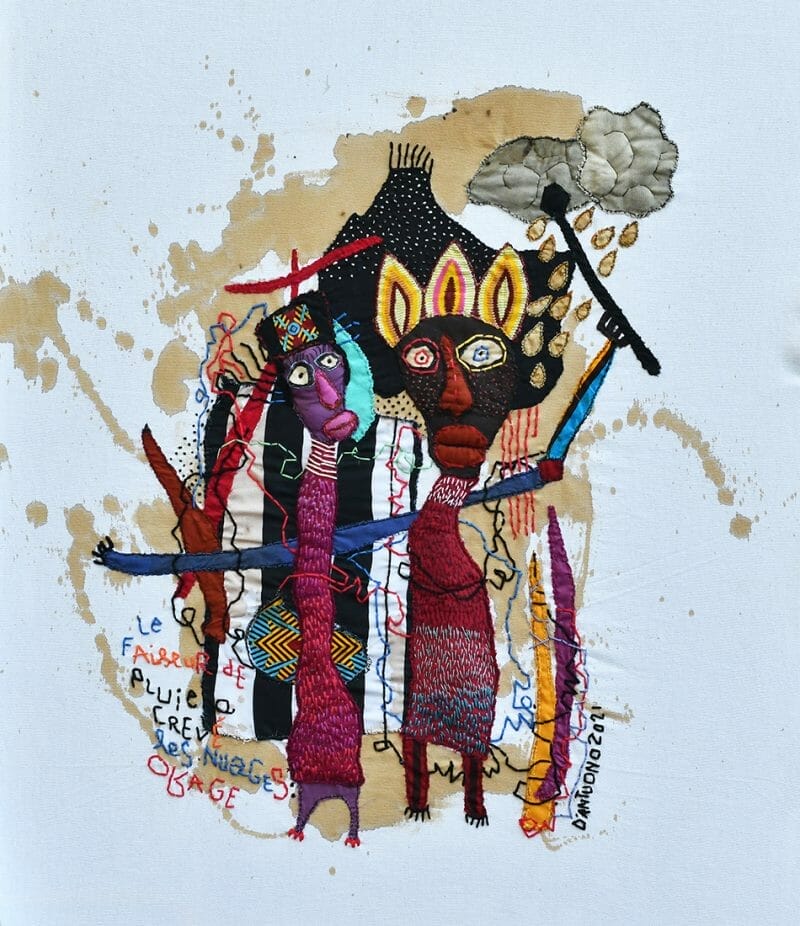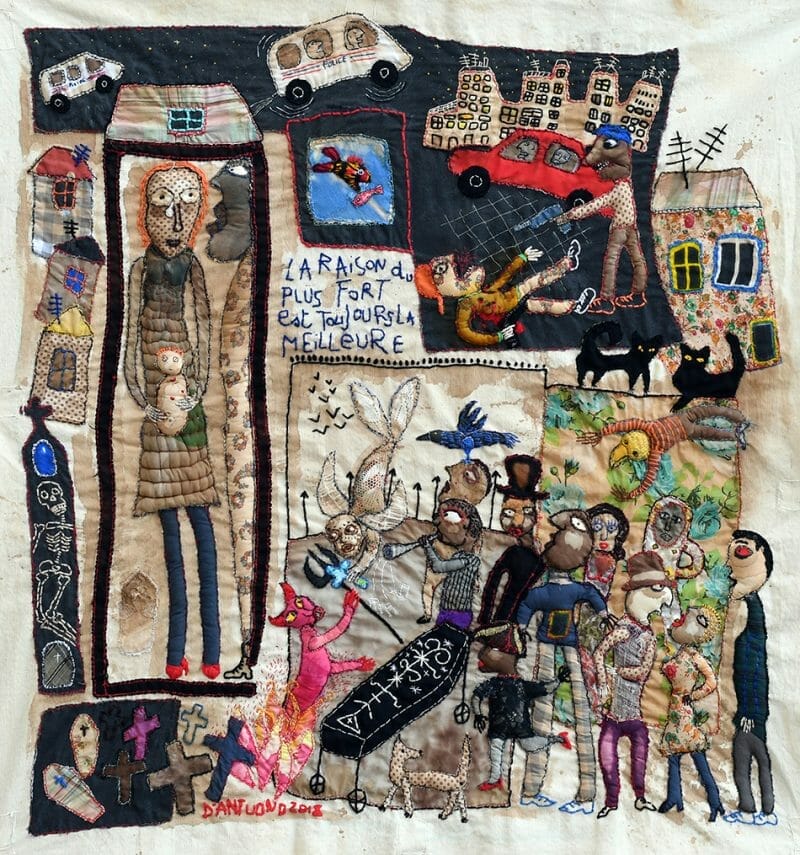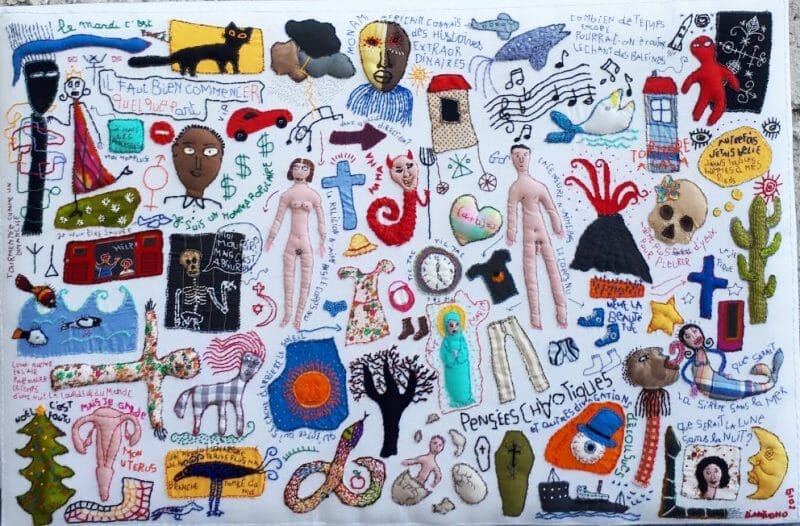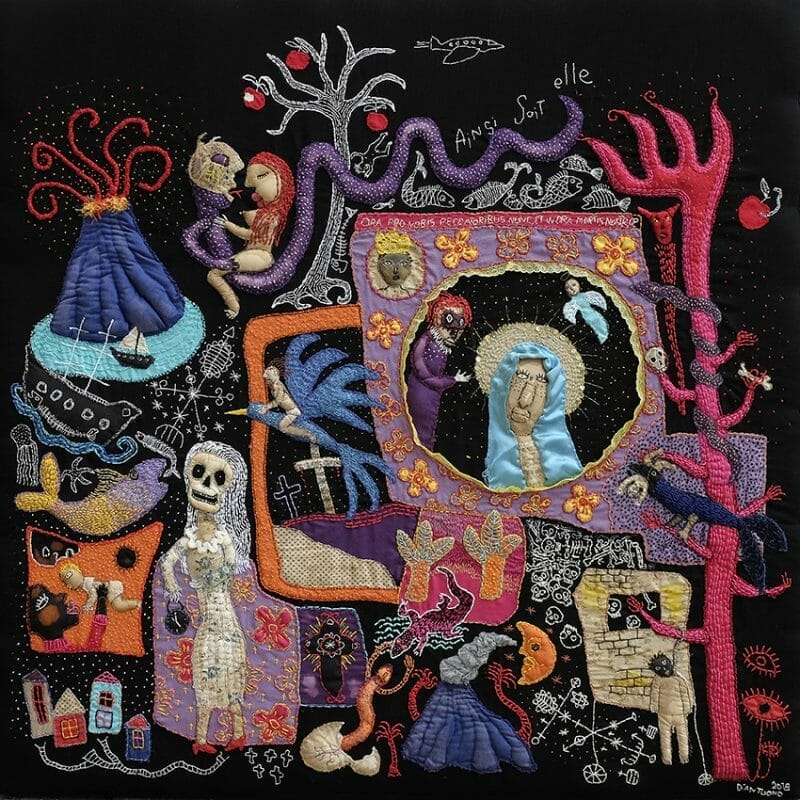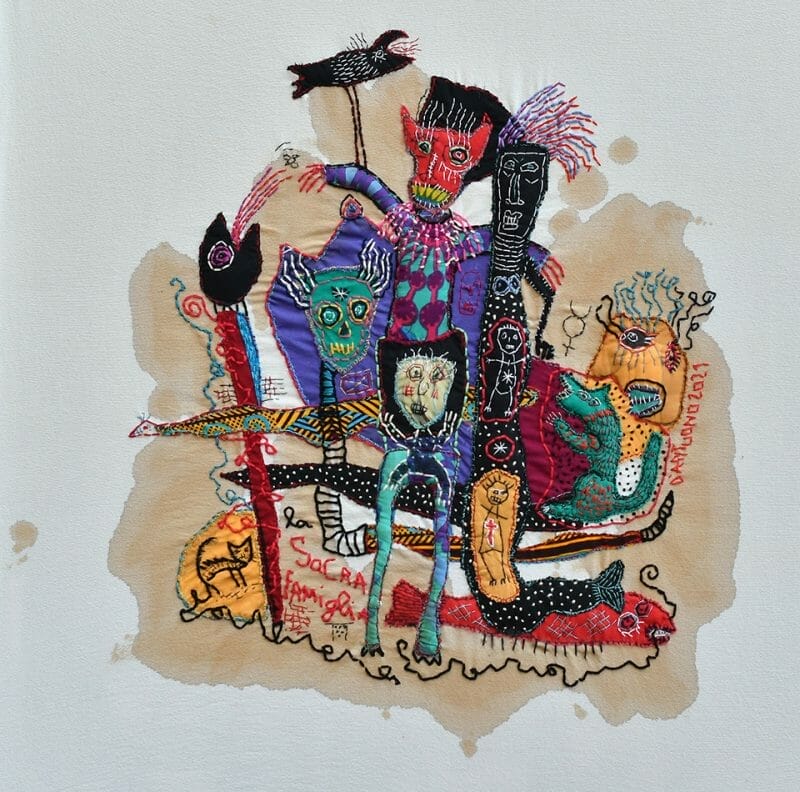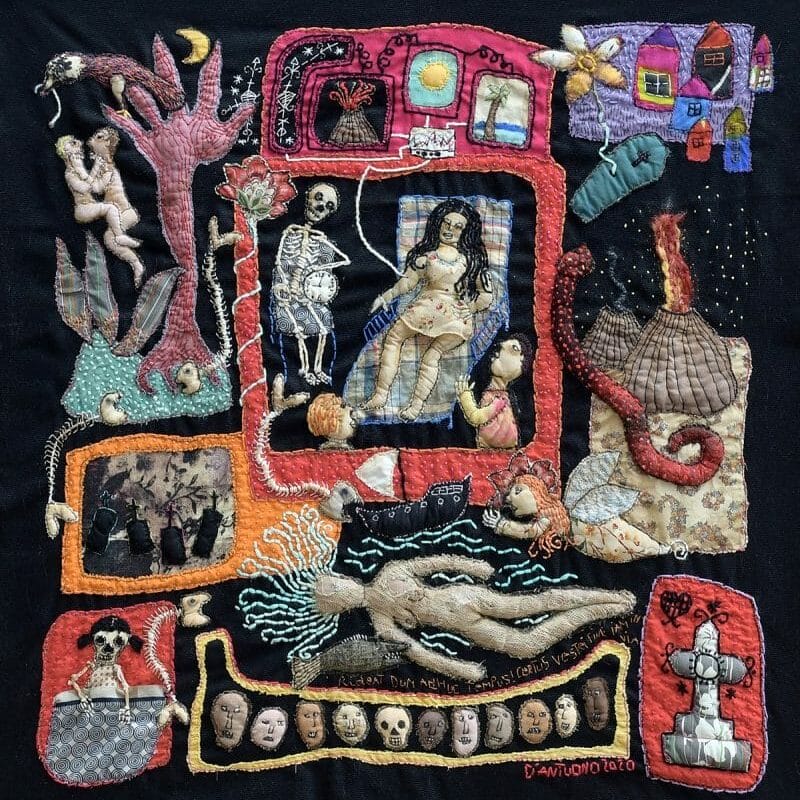BARBARA D’ANTUONO
*Featured photo: Pensées chaotiques Fond Noir-2019-BarbaradAntuono
It is the human being at the center of Barbara D’Antuono’s research (Varese, 1961) or rather her relationship with the sacred, magic, violence, death, the afterlife. An artistic practice that feeds on a multicultural stratification matured between France and the Caribbean but, above all, from the encounter with art brut (raw art), popular art and voodoo in Haiti where she lived for a long time and where her very personal expressive figure was born inspired by its beliefs and superstitions, by the wealth of symbolic and iconographic representations, rites and traditions.
For about ten years, textiles have been her medium of choice in an identification of sewing with a form of self-therapy capable of ‘suturing’ the wounds of existence. Through a creative process that finds its expressive form in the almost hypnotic gesture of the needle freed from the limit of a pre-established design or project, D’Antuono explores the depths of her own self in a meticulous and detailed work, full of mythological references and religious not without sometimes humorous accents.
Among the recent exhibitions in which she has exhibited, “Créatures des terres minées” Galerie Claire Corcia, Paris; “Esprits Vagabonds” retrospective for the release of the book “L’œil de la femme à barbe accueilli”, Galerie Claire Corcia, Paris; International Biennale of Arts Textiles, Haacht BE, “Empreintes textiles”, Center Culturel André Malraux, Agen; “Les démons au bout du fil”, Galerie des Art Ménagés, Paris and, again at the Galerie 3F and at the Galerie Monod in Paris and at the Festival d’Art Singulier in Saint Aubin Les Elbeuf.
Tra le mostre recenti in cui ha esposto, “Créatures des terres minées” Galerie Claire Corcia, Parigi; “Esprits Vagabonds” retrospettiva per l’uscita del libro “L’œil de la femme à barbe accueilli” , Galerie Claire Corcia, Parigi; Biennale Internationale d’Arts Textiles, Haacht BE, “Empreintes textiles”, Centre Culturel André Malraux, Agen; “Les démons au bout du fil”, Galerie des Art Ménagés, Parigi e, ancora alla Galerie 3F e alla Galerie Monod di Parigi e al Festival d’Art Singulier a Saint Aubin Les Elbeuf.
How did you come to art?
I was born in Varese. My father was from Puglia and my mother from Trentino.
We emigrated to Corsica in 1968 at a time when great social upheaval was taking place in France. It is therefore in Corsica that I grew up and did my primary and secondary education.
As a child, I was creative and had an abundant imagination. I showed an aptitude for all things manual and very early became interested in art in general. Quite naturally, my parents encouraged me in this direction by imagining a job related to the plastic arts for me
But the wind of revolt and freedom that blew after 1968, the emancipation of the woman who had just taken a leap forward and my certainty that the creative process had to free itself from any academic considerations led me to take another path. I could no longer think about my studies and so after my high school diploma I decided to discover the world.
The desire for adventure and to be «on the road» was in the air at that time. And so I set off on a sort of initiatory journey that took me to the Caribbean and Haiti. It was 1982. What was supposed to be just a stop on my journey turned into a stay that would last five years.
This small country of extraordinary cultural richness gave me an electric shock.
The encounter with the work of the painters of the St Soleil movement, the first rural artistic community, and their freedom of pictorial expression was decisive for me. Everything has become possible. Creating has become a need, a necessity.
Why did you choose the textile medium as an expressive language?
It hasn’t always been like this. Arriving in Haiti, my first creations were inspired more by popular art brut. Montage, collage, creations of fetishes, discovery of painting
Upon my return to France in 1986 I devoted myself almost exclusively to painting. However I started working with fabrics making voodoo inspired dolls. It was in 1999 that I started my first textile bas-relief, on the death of my father, while continuing to paint and later, in 2013 when my mother died, I definitively dedicated myself totally to it.
When I sew, I repair and embroider my worries and suture the wounds of the soul. Rebuild to rebuild. There is something hypnotic in the repeated gesture of the needle that crosses the fabric, assembles, superimposes. I bring my dead back to life (as in the Chroniques funebres series), I exorcise my demons. I tell stories of life and death by making them exist on the canvas, like a mantra that I recite. I no longer think, only the gesture counts. The appeasement is total, instantaneous as soon as I start sewing
I use fabric as a color palette. The texture, the prints, the decorative motifs, the diversity is unlimited, the raw material inexhaustible. Our consumer society produces without counting, we buy, throw away, buy again… I collect old clothes here and there, there’s no shortage of them, it’s good for me, it’s good for the planet.
On the other hand, for someone like me who travels often, sewing is very practical: very little material to bring, there is no need to have an atelier, I can be a nomad and this gives me a great feeling of freedom.
What are the sources of inspiration for your work? And what factors have most influenced your art?
I was immediately fascinated by the history of Haiti, the first black republic in the world (1804). I became interested in the voodoo cult and its spirits, its symbolism. The character of Baron Samedi, spirit of cemeteries, or Erzuli representation of the Virgin, characters you often find in my paintings.
Syncretism, a fusion of Judeo-Christian images, and voodoo, was my first source of inspiration, then, my work has been enriched with encounters: African art, raw art (art brut) in all its forms , folk art in general, not forgetting my first loves – the Italian Renaissance, Hieronymus Bosch, Gauguin, and many more.
Travel is also a great source of inspiration. I regularly trek active volcanoes. When you look at the bottom of a crater it is the heart of the earth that you see beating, it is an immense emotion.
Without forgetting the music that has always been part of my life.
What do you tell in your works? What meanings do they convey?
In 1986 I witnessed the coup that preceded the departure of the dictator Jean Claude Duvalier, son of the famous and bloodthirsty Papadoc. The state of emergency, the curfew, the abuses, the murders I witnessed shook me to the core.
Naturally, I wondered about violence, about our relationship with death, with the sacred, the place occupied by magic and superstitions very present in Haiti, our spirituality in relation to our human condition.
Back in France after these tragic events, I fell ill. It was very bad. I shouldn’t have survived. Fate decided otherwise. Death is therefore always present in my work.
I try to tame her, to compose with her. I imagine my mythology which I enrich in each new composition. There is no hell, no paradise, but a realm of the dead where nothing is fixed and has its own existence, a sort of “inframundo” as we find in Mayan mythology, an underworld where the dead find each other.
However, I don’t think my work is dark or morbid. The colors are always present. There is also an ironic, humorous figure. I tell universal stories, I keep a diary. I exorcise my demons by giving them substance on the canvas. I also transcribe my dreams.
I don’t have a set plan when I start on the canvas. I let the images come to me, I place no barriers, no censorship. I take what comes. Sometimes I write words, sometimes sentences, my pen is a needle, the ink is the thread.
Our worries, our fears, our beliefs but also motherhood, transmission, nature, the home, that’s what I’m talking about.
I am happy during my exhibitions when people tell me that my art makes them feel good, that they find themselves in my stories, that they echo their own experiences.
How has your art changed over time?
The first big change was the transition from paint to fabrics.
Regarding the form, it took me some time to perfect my technique for making bas-reliefs which required the manufacture of suitable tools. Today, I totally master this aspect of my job and as a result I’ve gained speed. For the larger pieces, on the other hand, I always need two to four months of intense work.
Deep down, I think I reveal myself more and more, I expose myself more. I’m talking about my inner self.
I like to explore my psyche, the more complex it is, the more material I have for my creations. In a certain sense, I am lying on the psychoanalyst’s couch and I tell everything that comes to my mind. My hands do the rest.
What has also changed is the desire to work in tandem with another artist, for some time now I have been collaborating with a composer The Talk of Creatures From the le Horla music prod label who composes original music and soundtracks for exhibitions, videos and teasers . The sound joins the picture. This is how I find my first love. The very particular music of this composer is in total symbiosis with my works and helps to create a mysterious and hypnotic atmosphere during my exhibitions.
One leads to the other. It’s very inspirational. Our collaboration will last over time.
Una conduce all’altra. È di grande ispirazione. La nostra collaborazione durerà nel tempo.
What does being an artist mean to you?
Having a singular sight on what surrounds us, feeling emotions strongly and having the urgency to transcribe them, without concessions, being able to grasp the beautiful in the ordinary and in the ugly, and above all having the absolute need to create.
But of course, all of this is mine, I guess everyone has their own definition of what it means to be an artist.

